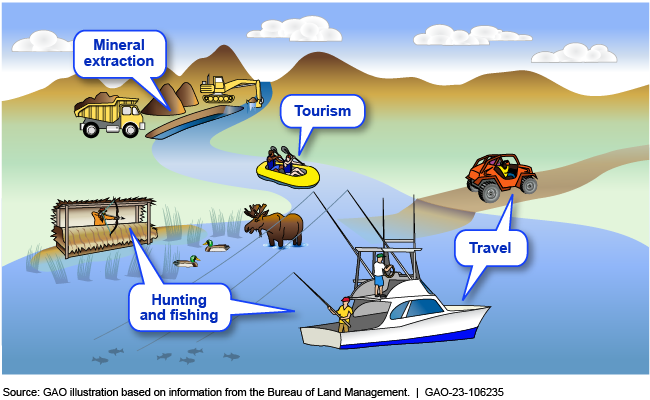Alaska Land Management: Resolving Ownership of Submerged Lands
Fast Facts
Lakes and rivers in Alaska often serve as key transportation corridors. Many of these waterways and the lands below them—including their beds, banks, and natural resources—are managed by the federal government. But under federal law, a state owns submerged lands beneath waters that were navigable as of the date of statehood—1959 for Alaska.
This Q&A describes the processes for resolving ownership of submerged lands and explores challenges related to managing them.
Our recommendations address ways the federal government could reduce intergovernmental conflicts and minimize public confusion over use of submerged lands.
Examples of Activities on Alaskan Waterways Where Federal and State Management May Differ

Highlights
What GAO Found
State and federal agencies have different missions, laws, and regulations that govern how they manage lands in Alaska. As a result, who owns submerged lands beneath waterways—the beds and banks of waterways and their associated natural resources, such as minerals— affects a range of land management functions, including collection of fees; decisions about use of resources, such as access to waterways for commercial tour operators; and law enforcement.
Two processes can be used for resolving the ownership of submerged lands, depending on the situation: an administrative process or a judicial process. Both processes can be complex and time-consuming.
Under the administrative process, since 2003, the Department of the Interior's Bureau of Land Management (BLM) has made determinations in 36 instances that Alaska owns specific submerged lands, in response to applications submitted by the state. The state has identified about 150 waterways of interest that it may include in future applications. The administrative process takes an average of 5 years to complete. The variation in processing time depends on several key factors such as the type and amount of available evidence and the complexity of the waterway, according to BLM officials.
The state of Alaska has filed at least 10 lawsuits using the judicial process since 1980, according to BLM. For closed cases, there have been a range of outcomes, including the court ruling in favor of either party. BLM officials indicated that the judicial process is expensive and complex and can take years to complete for each case.
While ownership of specific submerged lands is being resolved, federal land managers, such as BLM, Fish and Wildlife Service (FWS), National Park Service (NPS), and U.S. Forest Service have taken some steps towards management of these lands through an interagency workgroup. However, federal land management agencies have not developed a process for collaborative land management that involves the state. Such a process could reduce intergovernmental conflicts and uncertainties for the public and stakeholders, such as Alaska Native Corporations that own lands adjacent to waterways.
Why GAO Did This Study
GAO was asked to examine issues related to the ownership of submerged lands in Alaska. This report provides information on the processes used for resolving ownership of submerged lands in Alaska and actions federal agencies have taken to clarify land management responsibilities between the federal government and the state, while ownership of submerged lands is being resolved.
To do this work, GAO reviewed relevant laws, regulations, policies, and guidance related to the administrative and judicial processes for resolving ownership of submerged lands in Alaska. GAO also visited several waterways in Alaska with officials from BLM and the State of Alaska to help understand the considerations for making navigability determinations. GAO also held interviews with BLM and state officials, as well as other federal and non-federal stakeholders, to gain their views on the key steps and challenges with the administrative and judicial processes.
Recommendations
GAO is recommending that the Department of the Interior and the Department of Agriculture ensure that the relevant federal land management agencies coordinate to use third-party facilitation to help those agencies and the State of Alaska work toward agreement on a collaborative approach for management of submerged lands in Alaska.
Recommendations for Executive Action
| Agency Affected | Recommendation | Status |
|---|---|---|
| Department of the Interior |
Priority Rec.
The Secretary of the Interior should ensure that the Directors of BLM, FWS, and NPS coordinate with the Chief of the Forest Service to secure an independent third-party facilitator to help agencies within the Department of the Interior and the Department of Agriculture and the State of Alaska work toward agreement on a collaborative approach for the management of submerged lands in Alaska while ownership is being resolved. (Recommendation 1) |
As of May 2024, Interior and the Department of Agriculture are working together to coordinate with the State of Alaska to secure an independent third-party facilitator by a target date of October 1, 2024.
|
| Department of Agriculture | The Secretary of Agriculture should ensure that the Chief of the Forest Service coordinates with the Directors of BLM, FWS, and NPS to secure an independent third-party facilitator to help agencies within the Department of the Interior and the Department of Agriculture and the State of Alaska work toward agreement on a collaborative approach for the management of submerged lands in Alaska while ownership is being resolved. (Recommendation 2) |
As of May 2024, the Department of Agriculture and Interior are working together to coordinate with the State of Alaska to secure an independent third-party facilitator by a target date of October 1, 2024.
|
